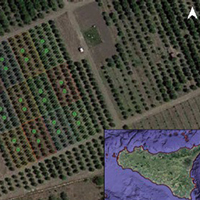Long-term monitoring of deficit irrigation regimes on citrus orchards in Sicily

Published:23 December 2021
Abstract Views: 1145
PDF: 517
HTML: 39
HTML: 39
Publisher's note
All claims expressed in this article are solely those of the authors and do not necessarily represent those of their affiliated organizations, or those of the publisher, the editors and the reviewers. Any product that may be evaluated in this article or claim that may be made by its manufacturer is not guaranteed or endorsed by the publisher.
All claims expressed in this article are solely those of the authors and do not necessarily represent those of their affiliated organizations, or those of the publisher, the editors and the reviewers. Any product that may be evaluated in this article or claim that may be made by its manufacturer is not guaranteed or endorsed by the publisher.
Similar Articles
- Abderrahman Sghaier, Hanen Dhaou, Lassaad Jarray , Zouhair Abaab, Ahmed Sekrafi, Mohamed Ouessar , Assessment of drought stress in arid olive groves using HidroMORE model , Journal of Agricultural Engineering: Vol. 53 No. 1 (2022)
- Francesca Valenti, Simona M.C. Porto, Giovanni Cascone, Claudia Arcidiacono, Potential biogas production from agricultural by-products in Sicily. A case study of citrus pulp and olive pomace , Journal of Agricultural Engineering: Vol. 48 No. 4 (2017)
- Mario Pirastru, Marcello Niedda, Mirko Castellini, Effects of maquis clearing on the properties of the soil and on the near-surface hydrological processes in a semi-arid Mediterranean environment , Journal of Agricultural Engineering: Vol. 45 No. 4 (2014)
- Andrea Setti, Giulio Castelli, Lorenzo Villani, Roberto Ferrise, Elena Bresci, Modelling the impacts of water harvesting and climate change on rainfed maize yields in Senegal , Journal of Agricultural Engineering: Vol. 54 No. 3 (2023)
- Behrooz Behboodi, Mohammad Gholami Parashkoohi, Davood Mohammad Zamani, Saeed Firouzi, A study comparing energy consumption and environmental emissions in ostrich meat and egg production , Journal of Agricultural Engineering: Vol. 56 No. 1 (2025)
- Juan Ãngel Mintegui Aguirre, José Carlos Robredo Sánchez, Carlos de Gonzalo Aranoa, Pablo Huelin Rueda, Jorge Fallas, Felipe Cisneros, Pedro Cisneros, Adriana Urciuolo, Rodolfo Iturraspe, Forest use strategies in watershed management and restoration: application to three small mountain watersheds in Latin America , Journal of Agricultural Engineering: Vol. 45 No. 1 (2014)
- Cesar Augusto Terán-Chaves, Sonia Mercedes Polo-Murcia, Cropping pattern simulation-optimization model for water use efficiency and economic return , Journal of Agricultural Engineering: Vol. 52 No. 4 (2021)
- Gabriella Impallomeni, Francesco Barreca, Agrivoltaic systems towards the European green deal and agricultural policies: a review , Journal of Agricultural Engineering: Vol. 56 No. 1 (2025)
- Ameneh Sobhani, Shawkat B.M. Hassan, Giovanna Dragonetti, Raffaella Balestrini, Mauro Centritto, Antonio Coppola, Alessandro Comegna, Comparing actual transpiration fluxes as measured at leaf-scale and calculated by a physically based agro-hydrological model , Journal of Agricultural Engineering: Vol. 54 No. 3 (2023)
- Farshad Haghjooy Maklavani, Mohammad Gholami Parashkoohi, Davood Mohammad Zamani, Hamed Afshari, Investigating the impact of integrating land consolidation with agricultural mechanization on the technical, energy, and environmental dimensions of paddy production , Journal of Agricultural Engineering: Vol. 56 No. 1 (2025)
You may also start an advanced similarity search for this article.

 https://doi.org/10.4081/jae.2021.1193
https://doi.org/10.4081/jae.2021.1193 











